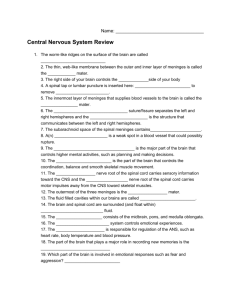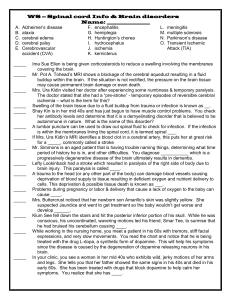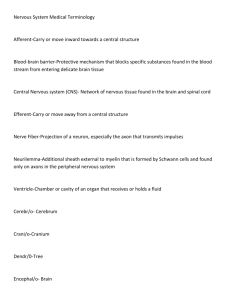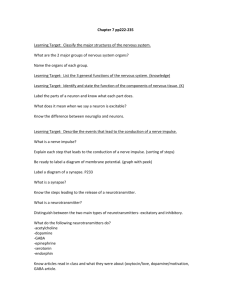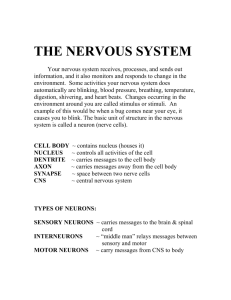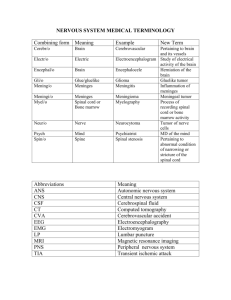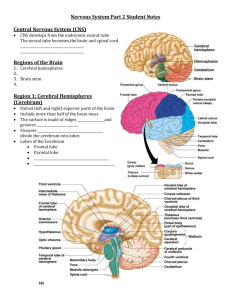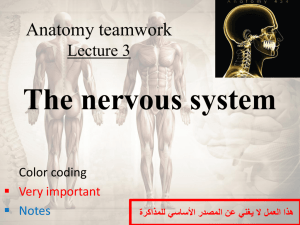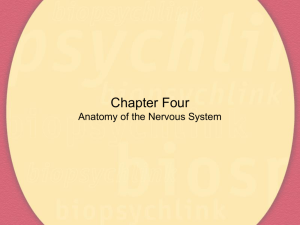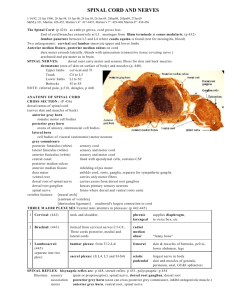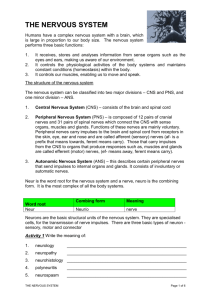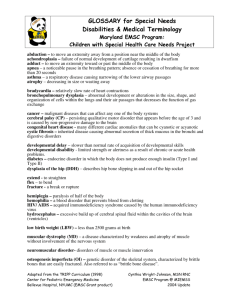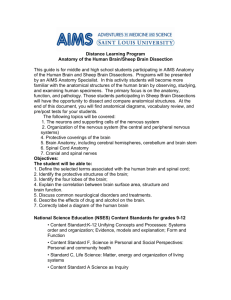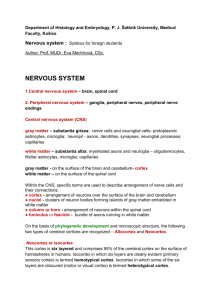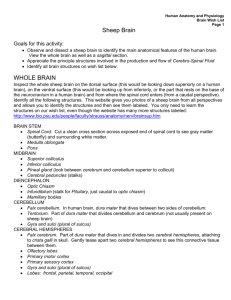Neurological Terminology
advertisement
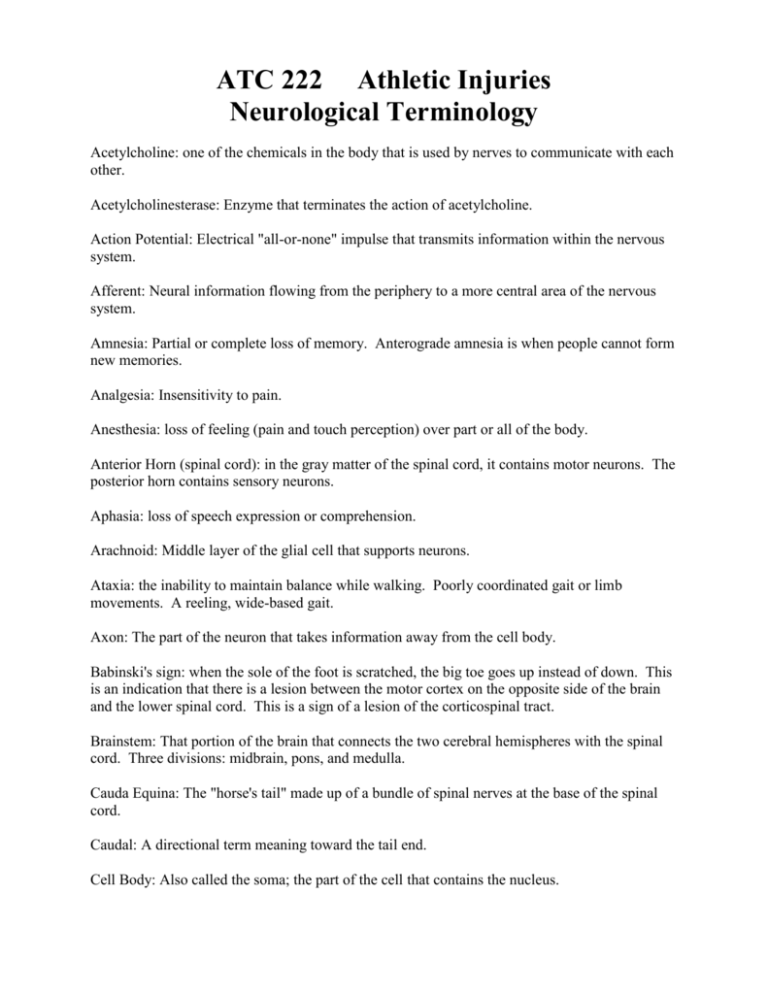
ATC 222 Athletic Injuries Neurological Terminology Acetylcholine: one of the chemicals in the body that is used by nerves to communicate with each other. Acetylcholinesterase: Enzyme that terminates the action of acetylcholine. Action Potential: Electrical "all-or-none" impulse that transmits information within the nervous system. Afferent: Neural information flowing from the periphery to a more central area of the nervous system. Amnesia: Partial or complete loss of memory. Anterograde amnesia is when people cannot form new memories. Analgesia: Insensitivity to pain. Anesthesia: loss of feeling (pain and touch perception) over part or all of the body. Anterior Horn (spinal cord): in the gray matter of the spinal cord, it contains motor neurons. The posterior horn contains sensory neurons. Aphasia: loss of speech expression or comprehension. Arachnoid: Middle layer of the glial cell that supports neurons. Ataxia: the inability to maintain balance while walking. Poorly coordinated gait or limb movements. A reeling, wide-based gait. Axon: The part of the neuron that takes information away from the cell body. Babinski's sign: when the sole of the foot is scratched, the big toe goes up instead of down. This is an indication that there is a lesion between the motor cortex on the opposite side of the brain and the lower spinal cord. This is a sign of a lesion of the corticospinal tract. Brainstem: That portion of the brain that connects the two cerebral hemispheres with the spinal cord. Three divisions: midbrain, pons, and medulla. Cauda Equina: The "horse's tail" made up of a bundle of spinal nerves at the base of the spinal cord. Caudal: A directional term meaning toward the tail end. Cell Body: Also called the soma; the part of the cell that contains the nucleus. Central nervous system: the part of the nervous system covered by the meninges. It includes the brain and spinal cord. Cerebellum: a part of the brain located above the brainstem. Its chief function concerns balance, posture, and coordination of movements. Cerebrospinal fluid (CSF): the fluid surrounding the brain and spinal cord. Cerebrum: forms the great bulk of the brain and consists of two hemispheres which occupy the entire vault of the cranium and are incompletely separated from each other by a deep median cleft, the longitudinal cerebral fissure. Clonus: rapidly alternating contraction and relaxation of a muscle. Coordination: an organized working together of muscles and groups of muscles aimed at bringing about a purposeful movement, such as walking or standing. Corpus callosum: Is a thick band which is the only connection between the two hemispheres of the cerebrum. Cerebral cortex: The outer layer of nerve cells that covers the entire surface of the cerebral hemispheres. Thinking and other complex neuronal activity occur in the cerebral cortex. Dendrite: The part of a neuron that carries impulses towards the cell body. Dorsal Root: Bundle of nerve fibers taking information into the spinal cord. Dura Mater: Outermost layer of the meninges. Dysarthia: Problems with the clarity or rhythm of speech. Dyesthesia: Distorted or unpleasant sensations experienced by a person when the skin is touched. Dysmetria: Inability to control range of movements. Dysphagia: Difficulty in swallowing. Dysphonia: Disorders of voice quality. Exacerbation: An increase in the severity of symptoms. Glands: A collection of cells specialized to secrete materials unrelated to the ordinary needs. Salivary glands are an example. Gray Matter: Portions of the CNS where nerve cell bodies are concentrated. Hemianopsia: One-sided visual field loss. Hemiparesis: Sensory loss or weakness of the face, arm and leg on one side of the body. Hemiplegia: Paralysis of one side of the body, including one are and one leg. Hypothalamus: Brain structure that monitors internal environment and attempts to maintain balance of the systems. Controls the pituitary. Impairment: Any loss or abnormality of psychological, physiological, or anatomical structure or function. Lateral Spinothalamic Tract: A tract in the anterior-lateral portion of the spinal cord. Interruption of the LST results in loss of pain and temperature sensation below the level of the interruption on the opposite side of the body. Medulla: Part of the brain stem important for breathing, respiration and other behaviors. Meninges: Series of 3 membranes (dura mater, arachnoid, pia mater) that cover the CNS. Myelin Sheath: Fatty substance that surrounds some axons. Nerve fibers: Fibers that extend from the body of a nerve cell that transmit electrical pulses as part of the information handling in the nervous system. Neuron: An individual nerve cell. Neurotransmitters: Chemicals that transmit information across the synapse to communicate from one neuron to another. Nystagmus: Rhythmical jerking movements of the eyes. Rapid, involuntary movements of the eyes in a horizontal or vertical direction. Occipital Lobe: Area of the brain located behind the parietal and temporal lobes and responsible for vision. Paralysis: Inability to move a part of the body. Paraparesis: A weakness but not total paralysis of the lower extremities. Paresis: Partial or incomplete paralysis of a part of the body. Paresthesia: Sensation of "pins and needles". Peripheral Nervous System: All the nerves and nerve cells outside the CNS. Pia Mater: Innermost layer of the meninges. Adjacent to the surface of the brain. Pituitary: "Master" gland attached to the base of the brain that secretes hormones. Plantar Reflex: A reflex response obtained by drawing a pointed object along the outer border of the sole of the foot from the heel to the little toe. The normal flexor response is a bunching and downward movement of the toes. Pons: the portion of the brainstem which contains the respiratory center. Prospective memory: The ability to remember an event or commitment planned for the future. Quadriplegia: The paralysis of both arms and both legs. Reflex: An involuntary response of the nervous system to a stimulus, such as the stretch reflex. Remote memory: The ability to remember people or events from the distant past. Rhomberg's Sign: Loss of position sense indicated by the patient's inability to remain immobile with his feet together and eyes closed. Rhomberg Test: A test where an individual's stance is tested by having the person stand with feet together, arms outstretched in front, and eyes open and then closed. Sensory: Related to bodily sensation such as pain, smell, taste, temperature, vision, hearing, acceleration and position in space. Spasticity: Increased muscle tone. Increased resistance to movement. Synapse: The anatomically specialized junction between two neurons. Thalamus: Group of nuclei in the diencephalon of the brain. The different nuclei have sensory and motor functions. Tract: A bundle of axons traveling together. In most cases, the origin and destination of the axons in a tract are quite similar. Vertigo: The feeling that one's environment is spinning or moving. White Matter: The part of the CNS containing mostly axons.


